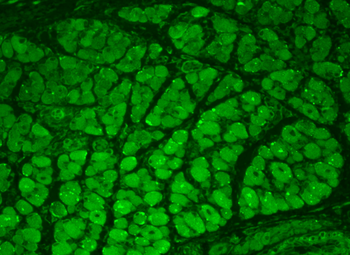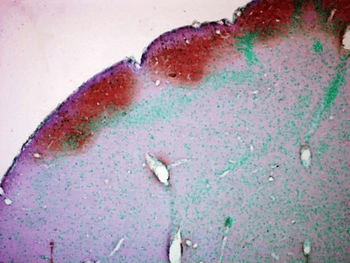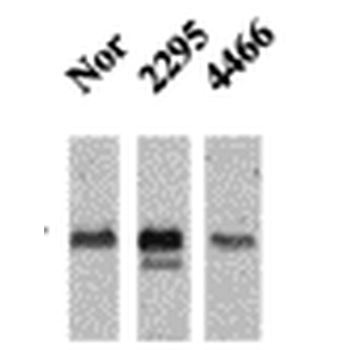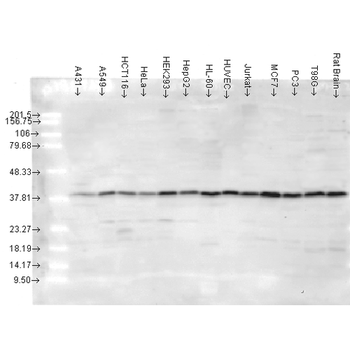You have no items in your shopping cart.
p38 alpha (MAP Kinase) Antibody: APC
Catalog Number: orb147363
| Catalog Number | orb147363 |
|---|---|
| Category | Antibodies |
| Description | Mouse monoclonal to p38 alpha (APC). The MAPK (mitogen activated protein kinase) comprises a family of ubiquitous praline-directed, proteinserine/ threonine kinases which signal transduction pathways that control intracellular events including acute responses to hormones and major developmental changes in organisms. This super family consists of stress activated protein kinases (SAPKs); extracellular signal-regulated kinases (ERKs); and p38 kinases, each of which forms a separate pathway. The kinase members that populate each pathway are sequentially activated by phosphorylation. Upon activation, p38 MAPK/SAPK2alpha translocates into the nucleus where it phosphorylates one or more nuclear substrates, effecting transcriptional changes and other cellular processes involved in cell growth, division, differentiation, inflammation, and death. Specifically p38 always acts as a pro-apoptotic factor with its activation leading to the release of cytochrome c from mitochondria and cleavage of caspase 3 and its downstream effector, PARP. p38 MAPK is activated by a variety of chemical stress inducers including hydrogen peroxide, heavy metals, anisomycin, sodium salicylate, LPS, and biological stress signals such as tumor necrosis factor, interleukin-1, ionizing and UV irradiation, hyperosmotic stress and chemotherapeutic drugs. As a result, p38 alpha has been widely validated as a target for inflammatory disease including rheumatoid arthritis, COPD and psoriasis and has also been implicated in cancer, CNS and diabetes.. |
| Species/Host | Mouse |
| Clonality | Monoclonal |
| Clone Number | 9F12 |
| Tested applications | ICC, IF, IHC |
| Reactivity | Human, Mouse, Rat |
| Isotype | IgG1 |
| Immunogen | Full length recombinant protein expressed in E.coli cells |
| Concentration | 1 mg/ml |
| Dilution range | WB (1:1000), IHC (1:1000) |
| Conjugation | APC |
| MW | 38kDa |
| Target | p38 MAPK |
| Entrez | 1432 |
| UniProt ID | Q16539 |
| NCBI | NP_001306.1 |
| Storage | Conjugated antibodies should be stored according to the product label |
| Buffer/Preservatives | 95.64mM Phosphate, 2.48mM MES and 2mM EDTA |
| Alternative names | CSAID Binding protein 1 antibody, CSBP1 antibody, Read more... |
| Note | For research use only |
| Application notes | Detects ~38kDa protein corresponding to p38α MAPK when loaded with 6 ng of purified p38α by chemiluminescent immunoblot analysis using Goat anti-mouse IgG:HRP as the secondary antibody. |
| Expiration Date | 12 months from date of receipt. |

Immunohistochemistry analysis using Mouse Anti-p38 MAPK Monoclonal Antibody, Clone 9F12. Tissue: Retinal Injury Model. Species: Mouse. Primary Antibody: Mouse Anti-p38 MAPK Monoclonal Antibody at 1:1000. Secondary Antibody: Alexa Fluor 594 Goat Anti-Mouse (red).
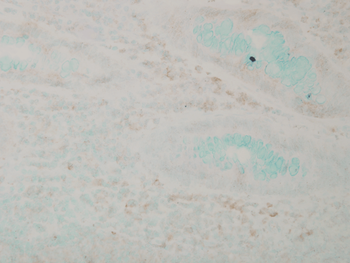
Immunohistochemistry analysis using Mouse Anti-p38 MAPK Monoclonal Antibody, Clone 9F12. Tissue: colon carcinoma. Species: Human. Fixation: Formalin. Primary Antibody: Mouse Anti-p38 MAPK Monoclonal Antibody at 1:10000 for 12 hours at 4°C. Secondary Antibody: Biotin Goat Anti-Mouse at 1:2000 for 1 hour at RT. Counterstain: Mayer Hematoxylin (purple/blue) nuclear stain at 200 μl for 2 minutes at RT. Magnification: 40x.
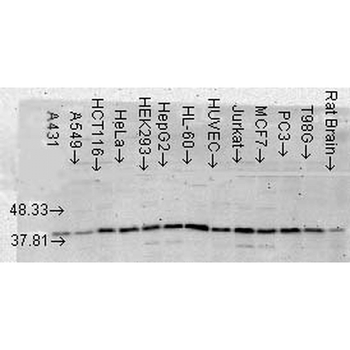
Western Blot analysis of Human Cell lysates showing detection of p38 MAPK protein using Mouse Anti-p38 MAPK Monoclonal Antibody, Clone 9F12. Load: 15 μg. Block: 1.5% BSA for 30 minutes at RT. Primary Antibody: Mouse Anti-p38 MAPK Monoclonal Antibody at 1:1000 for 2 hours at RT. Secondary Antibody: Sheep Anti-Mouse IgG: HRP for 1 hour at RT.
p38 Antibody: APC [orb151878]
ICC, IF, IHC
Bovine, Canine, Gallus, Guinea pig, Hamster, Human, Monkey, Mouse, Porcine, Rabbit, Rat, Sheep
Rabbit
Polyclonal
APC
100 μlPhospho-P38 MAPK (Thr180 + Tyr182) Rabbit Polyclonal Antibody (APC) [orb1005756]
FC, IF
Canine, Rabbit
Human, Mouse, Rat
Rabbit
Polyclonal
APC
100 μlPhospho-p38 MAPK (Tyr323) Rabbit Polyclonal Antibody (APC) [orb1007402]
IF
Canine, Equine, Gallus, Porcine, Rabbit, Rat
Human, Mouse
Rabbit
Polyclonal
APC
100 μlPhospho-P38 MAPK (Thr180) Rabbit Polyclonal Antibody (APC) [orb1007403]
FC, IF
Canine, Equine, Gallus, Porcine, Rabbit
Human, Mouse, Rat
Rabbit
Polyclonal
APC
100 μl



